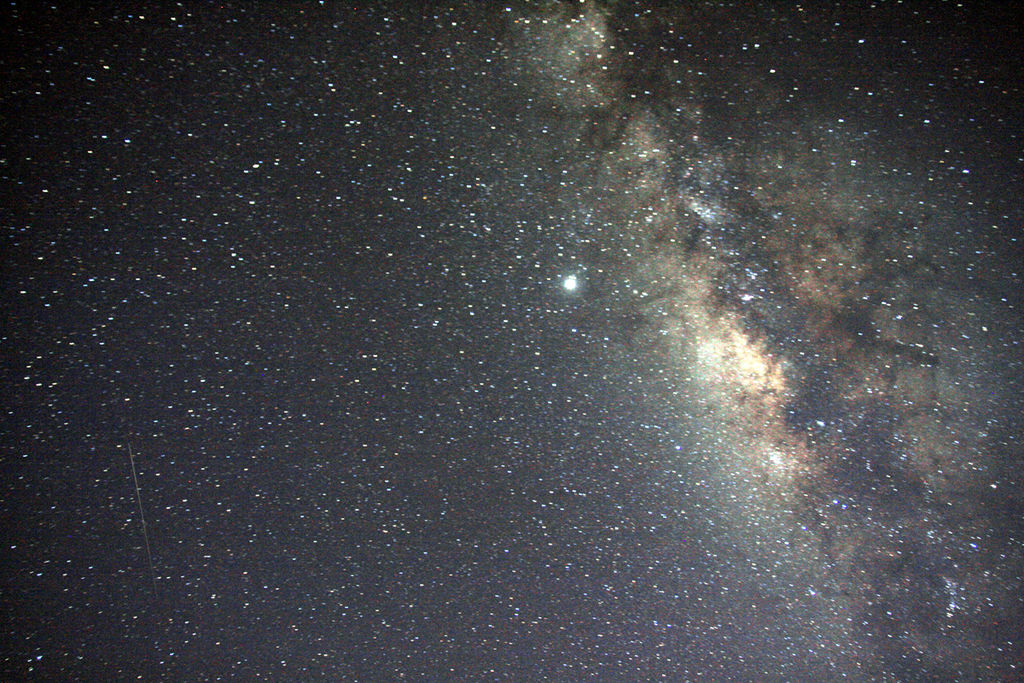
A meteor and galactic center of Milky Way galaxy. The image was taken in Hawaii Volcanoes National Park: photo by Mila Zinkova, 21 September 2008
Keep what I give you
a covenant
we shall inherit
the unimaginable
immaculate loneliness
of galaxies.
Vassilis Zambaras: from The Intricate Evasions of As (Kater Murr's Press, 1998)
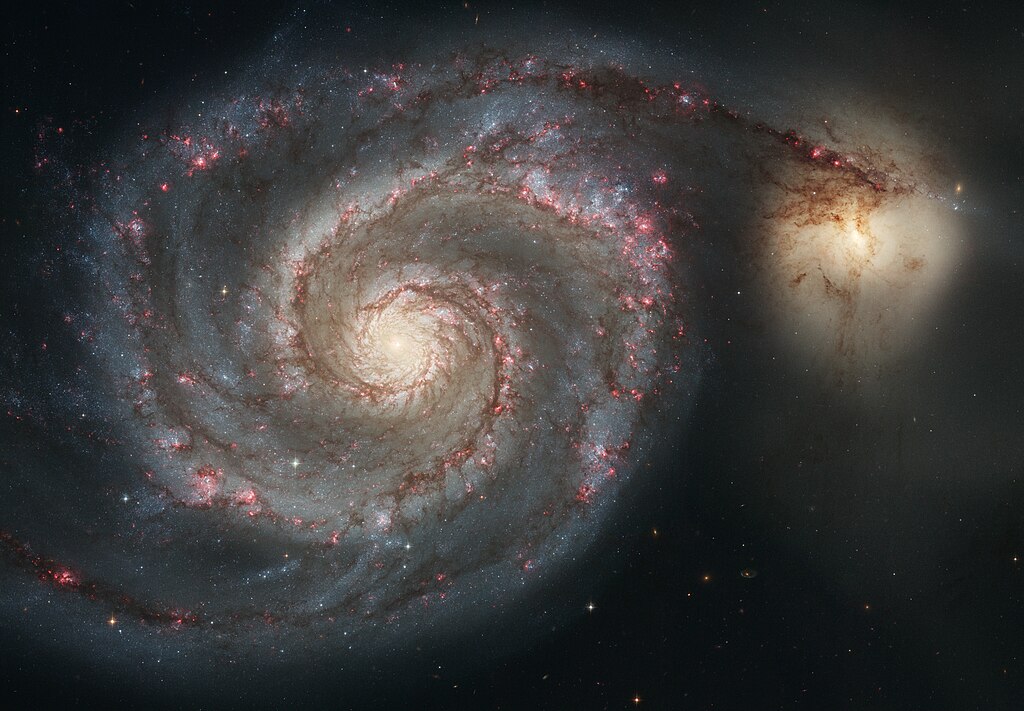
The Whirlpool Galaxy (Spiral Galaxy M51, NGC 5194), a classic spiral galaxy located in the Canes Venatici constellation: image by NASA/ESA, January 2005
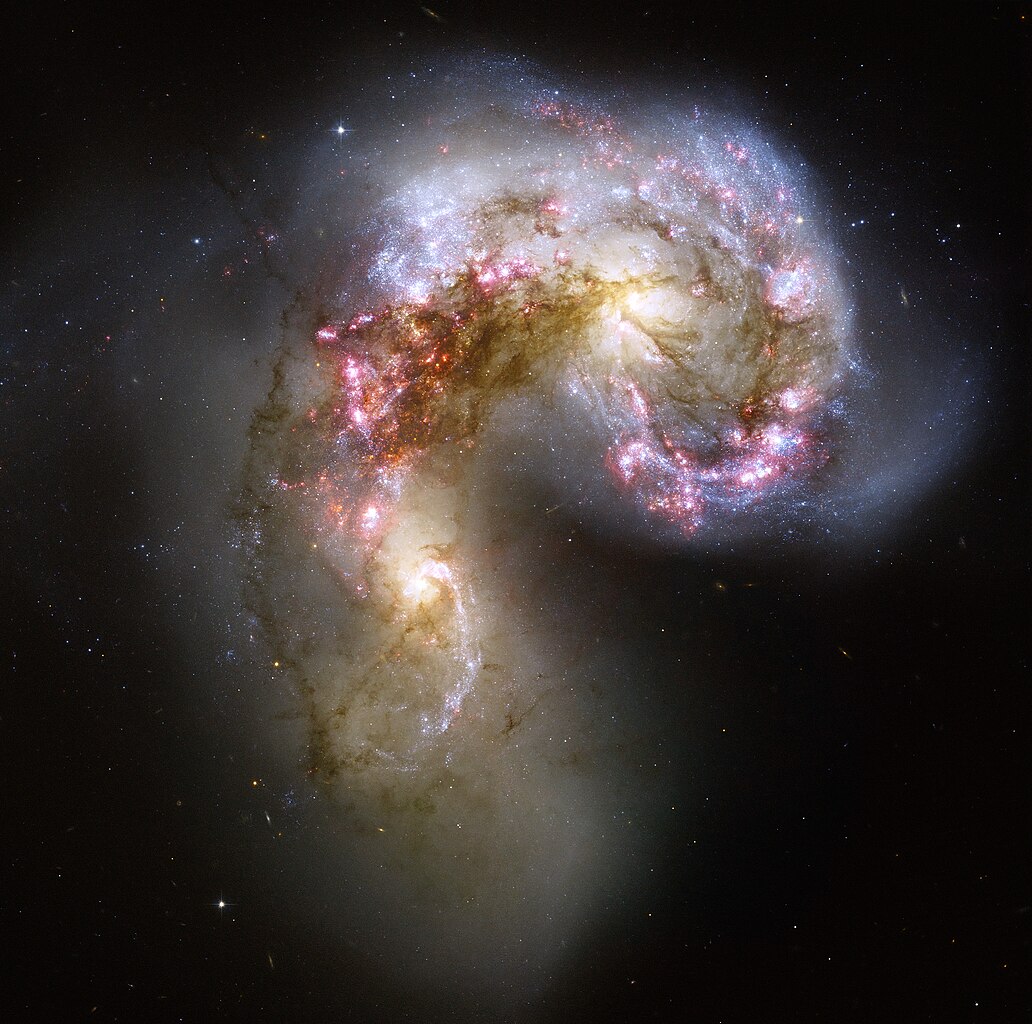
The Antennae Galaxies (NGC 4038 & 4039), a merging pair of spiral galaxies. During the course of the collision, billions of stars will be formed. The brightest and most compact of these star birth regions are called super star clusters.The two spiral galaxies started to interact a few hundred million years ago, making the Antennae Galaxies one of the nearest and youngest examples of a pair of colliding galaxies. Nearly half of the faint objects in the Antennae image are young clusters containing tens of thousands of stars. The orange blobs to the left and right of image center are the two cores of the original galaxies and consist mainly of old stars criss-crossed by filaments of dust, which appear brown in the image. The two galaxies are dotted with brilliant blue star-forming regions surrounded by glowing hydrogen gas, appearing in the image in pink: Hubble Space Telescope image by NASA, ESA, and the Hubble Heritage Team (STScI/AURA)-ESA), 16 October 2006
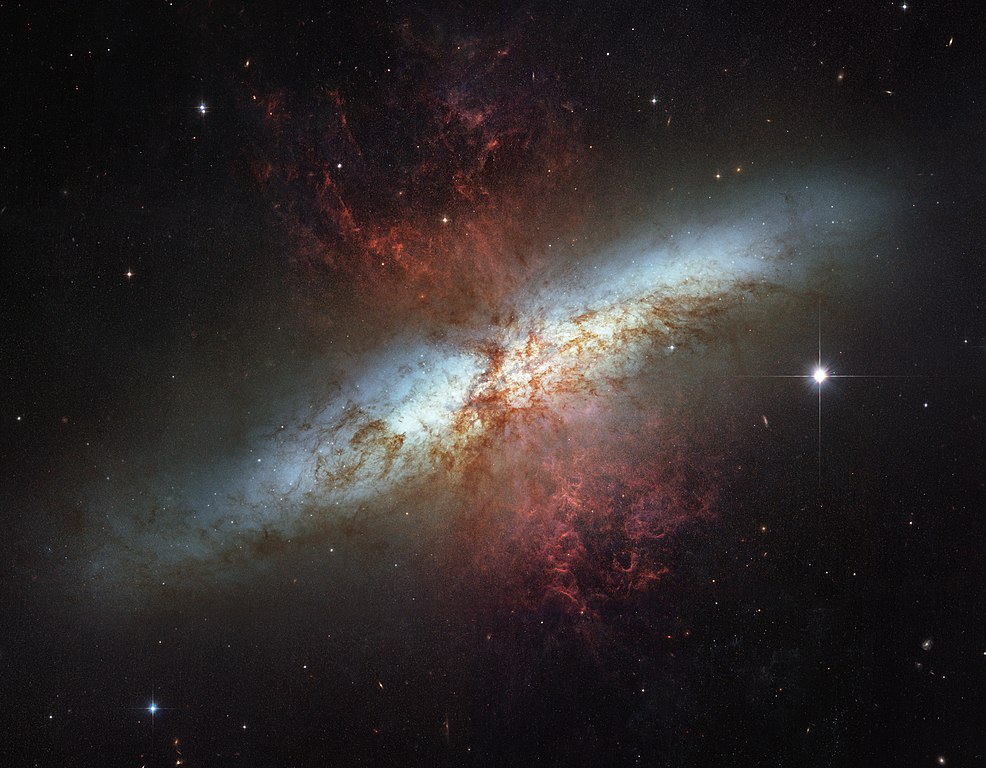
The starburst galaxy Messier 82 (M82). The galaxy is remarkable for its bright blue disk, webs of shredded clouds, and fiery-looking plumes of glowing hydrogen blasting out of its central regions. Throughout the galaxy's center, young stars are being born 10 times faster than stars are born inside our Milky Way Galaxy. The resulting huge concentration of young stars is carved into the gas and dust at the galaxy's center. The fierce galactic superwind generated from these stars compresses enough gas to make more millions of stars. In M82, young stars are crammed into tiny but massive star clusters. These, in turn, congregate by the dozens to make the bright patches, or "starburst clumps," in the central parts of M82. Most of the pale, white objects sprinkled around the body of M82 that look like fuzzy stars are actually individual star clusters about 20 light-years across and contain up to a million stars. The rapid rate of star formation in this galaxy eventually will be self-limiting. When star formation becomes too vigorous, it will consume or destroy the material needed to make more stars. The starburst then will subside, probably in a few tens of millions of years. Located 12 million light-years away, M82 appears high in the northern spring sky in the direction of the constellation Ursa Major, the Great Bear. It is also called the "Cigar Galaxy" because of the elliptical shape produced by the oblique tilt of its starry disk relative to our line of sight: mosaic image by NASA, ESA, and The Hubble Heritage Team (STScI/AURA), 24 April 2006
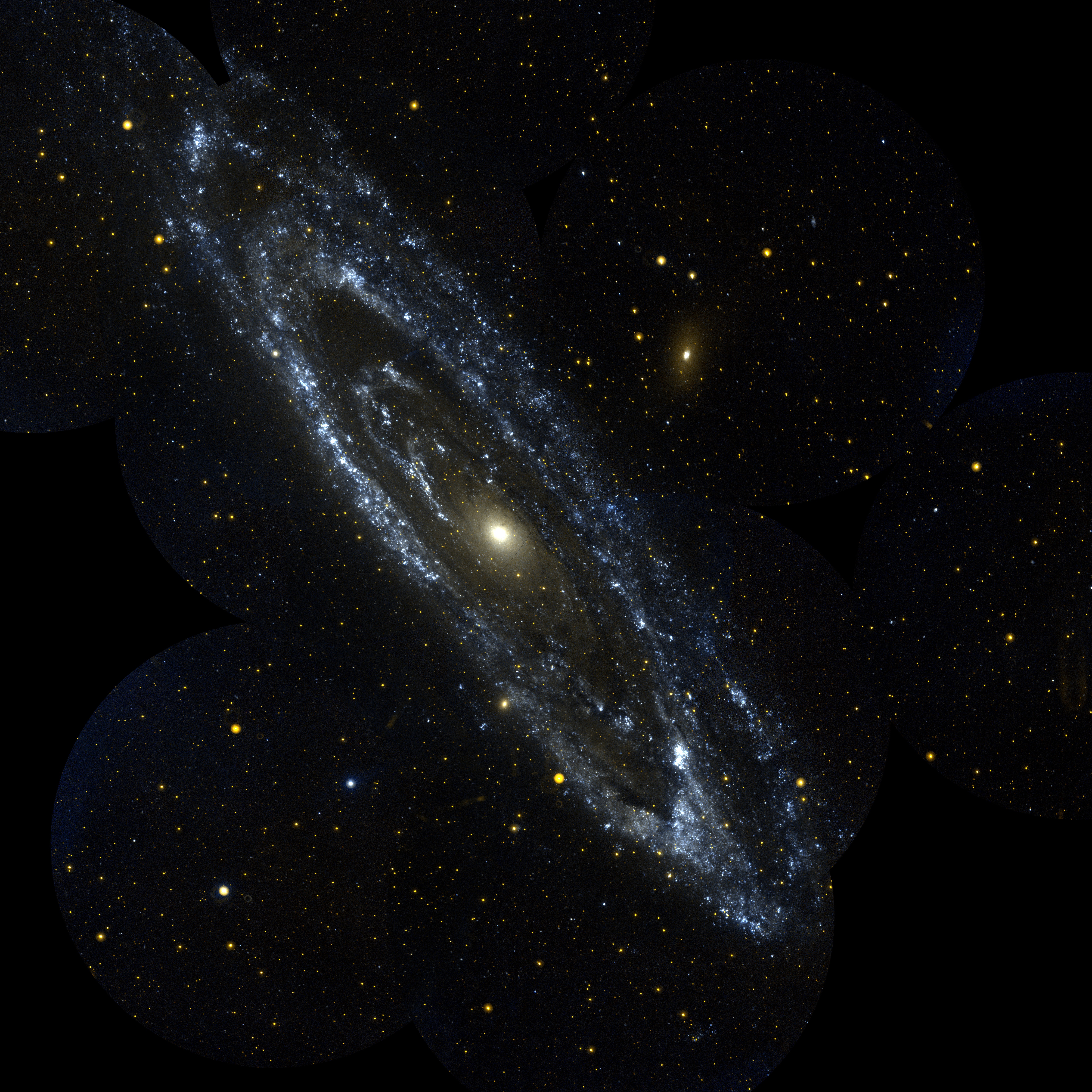
Galaxy Evolution Explorer observation of the large galaxy in Andromeda, Messier 31. The Andromeda galaxy is the second massive in the local group of galaxies that includes our Milky Way. Andromeda is the nearest large galaxy to our own. The image is a mosaic of 10 separate Galaxy Evolution Explorer images taken in September, 2003. The color image (with near ultraviolet shown by red and far ultraviolet shown by blue) shows blue regions of young, hot, high mass stars tracing out the spiral arms where star formation is occurring, and the central orange-white "bulge" of old, cooler stars formed long ago. The star forming arms of Messier 31 are unusual in being quite circular rather than the usual spiral shape. Several companion galaxies can also be seen. These include Messier 32, a dwarf elliptical galaxy directly below the central bulge and just outside the spiral arms, and Messier 110 (M110), which is above and to the right of the center. M110 has an unusual far ultraviolet bright core in an otherwise "red", old star halo. Many other regions of star formation can be seen far outside the main body of the galaxy: ultraviolet wave image by Jet Propulsion Lab, NASA/California Institute of Technology, 10 December 2003

- Hubble Space Telescope view of the disk galaxy NGC 5866, seen tilted nearly edge-on to our line-of-sight. Hubble's sharp vision reveals a crisp dust lane dividing the galaxy into two halves. The image highlights the galaxy's structure: a subtle, reddish bulge surrounding a bright nucleus, a blue disk of stars running parallel to the dust lane, and a transparent outer halo. Some faint, wispy trails of dust can be seen meandering away from the disk of the galaxy out into the bulge and inner halo of the galaxy. The outer halo is dotted with numerous gravitationally bound clusters of nearly a million stars each, known as globular clusters. Background galaxies that are millions to billions of light-years farther away than NGC 5866 are also seen through the halo. NGC 5866 is a disk galaxy of type "S0" (pronounced s-zero). Viewed face on, it would look like a smooth, flat disk with little spiral structure. It remains in the spiral category because of the flatness of the main disk of stars as opposed to the more spherically rotund (or ellipsoidal) class of galaxies called "ellipticals." Such S0 galaxies, with disks like spirals and large bulges like ellipticals, are called "lenticular'" galaxies. The dust lane is slightly warped compared to the disk of starlight. This warp indicates that NGC 5866 may have undergone a gravitational tidal disturbance in the distant past, by a close encounter with another galaxy. This is plausible because it is the largest member of a small cluster known as the NGC 5866 group of galaxies. The starlight disk in NGC 5866 extends well beyond the dust disk. This means that dust and gas still in the galaxy and potentially available to form stars does not stretch nearly as far out in the disk as it did when most of these stars in the disk were formed. The Hubble image shows that NGC 5866 shares another property with the more gas-rich spiral galaxies. Numerous filaments that reach out perpendicular to the disk punctuate the edges of the dust lane. These are short-lived on an astronomical scale, since clouds of dust and gas will lose energy to collisions among themselves and collapse to a thin, flat disk. For spiral galaxies, the incidence of these fingers of dust correlates well with indicators of how many stars have been formed recently, as the input of energy from young massive stars moves gas and dust around to create these structures. The thinness of dust lanes in S0s has been discussed in ground-based galaxy atlases, but it took the resolution of Hubble to show that they can have their own smaller fingers and chimneys of dust. NGC 5866 lies in the Northern constellation Draco, at a distance of 44 million light-years (13.5 Megaparsecs). It has a diameter of roughly 60,000 light-years (18,400 parsecs), only two-thirds the diameter of the Milky Way, although its mass is similar to that of our galaxy: image by NASA, ESA, and The Hubble Heritage Team (STScI/AURA), 8 June 2006
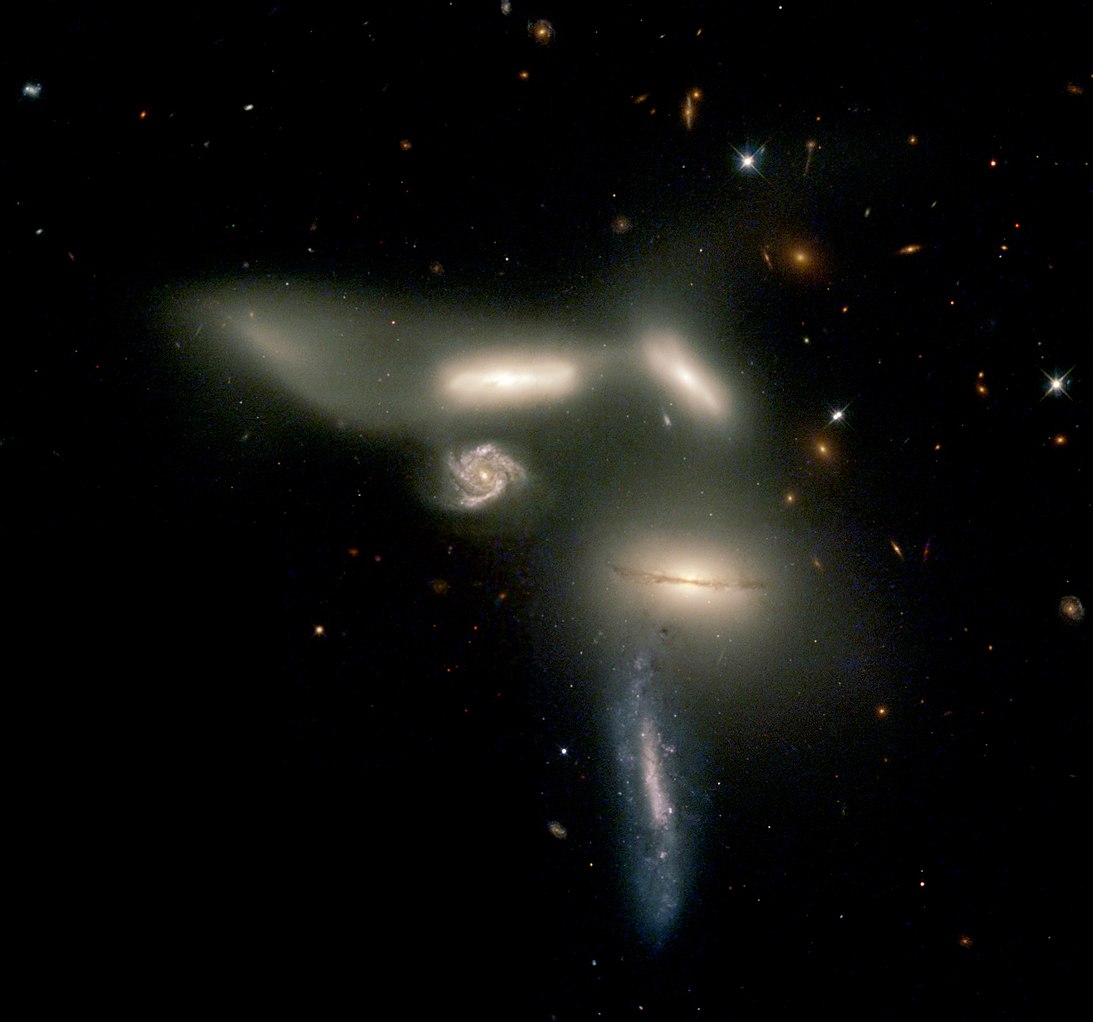
The Seyfert's Sextet, a compact galaxy group: image by HST/NASA/ESA, 3 May 2008

No comments:
Post a Comment